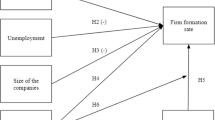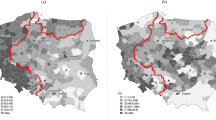Abstract
This paper explores spatial and temporal contexts for entrepreneurship at both the regional and country level in Spain during three different periods from 2002 to 2018. Using institutional data, we find significant differences in the conditions influencing new firm formation rates by regions. Such variations in firm formation rates are mainly explained by unemployment and economic stagnation in the presence of high population density before and during the economic crisis periods. However, human capital greatly determines entrepreneurship starting in 2015. This study illustrates how a contextualized view of entrepreneurship contributes to our understanding of this phenomenon. As a result, our work enriches our understanding of the dynamic socioeconomic drivers motivating entrepreneurial action.

Similar content being viewed by others
Notes
INE: Instituto Nacional de Estadística.
DIRCE: Directorio Central de Empresas, INE.
MECD. Ministry of education and professional training. Provides indicators related to contextual factors that can influence the activity and education situation.
INE: The National Statistics Institute is a legally independent administrative Autonomous institution assigned to the Ministry of Economy and Business, via the Secretary of State for the Economy and Business Support.
DIRCE. Central directory of companies brings together in a unique information system all Spanish companies and their local units located in the national territory. It includes all economic activities except Agriculture and Fisheries, Public Administration, Defense and Compulsory Social Security, the activities of households that employ domestic personnel and Extraterritorial Organizations.
EFPA. The Economically Active Population Survey (EAPS) has been conducted since 1964. The current methodology has been used since 2005.This continuous and quarterly research is aimed at families, intended to collect data on the labor force and its various categories (employed, unemployed) as well as on the population outside the labor market (inactive). The initial sample is taken from about 65,000 families per quarter, equivalent to approximately 160,000.
CRE. The Spanish Regional Accounts (SRA) is a statistical operation that the INE has been carrying out conducted since 1980 and whose main objective is to provide a quantified, systematic and as complete a description as possible of the regional economic activity in Spain (Autonomous Communities and provinces), during the considered reference period. This information allows the analysis and evaluation of the structure and development of the regional economies and serves as a statistical base for the design, execution, and monitoring of regional policies. The regional accounts are a specification of the national accounts; that is, the Spanish National Accounts (SNA) are the conceptual and quantitative framework in which the SRA is integrated.
Population figures provide a quantitative measurement of the population resident in Spain, in each autonomous community. Population series since 1971, which is obtained from the intercensal estimates of the population, for the period 1971–2012, and from the operation Population figures itself, as of 2012. The Register of inhabitants of May 1, 1996 of the I.N.E. it is the source of information for the calculation of the indicators in table 1.1: Population density; Percentage of population from 0 to 29 years and territorial extension.
References
Ács, Z. J., Szerb, L., & Autio, E. (2016). Global entrepreneurship and development index 2015. Springer.
Acs, Z., & Armington, C. (2004). Employment growth and entrepreneurial activity in cities. Regional Studies, 38(8), 911–927.
Albulescu, C. T., & Tămăşilă, M. (2016). Exploring the role of FDI in enhancing the entrepreneurial activity in Europe: a panel data analysis. International Entrepreneurship and Management Journal, 12(3), 629–657.
Amorós, J. E., Poblete, C., & Mandakovic, V. (2019). R&D transfer, policy and innovative ambitious entrepreneurship: evidence from Latin American countries. The Journal of Technology Transfer, 44(5), 1396–1415.
Aragon-Mendoza, J., del Val, M. P., & Roig-Dobón, S. (2016). The influence of institutions development in venture creation decision: A cognitive view. Journal of Business Research, 69(11), 4941–4946.
Armington, C., & Acs, Z. (2002). The determinants of regional variation in new firm formation. Regional Studies, 36(1), 33–45.
Audretsch, D. B. (1995). Innovation and industry evolution. Mit Press.
Audretsch, D. B., & Fritsch, M. (1994). The geography of firm births in Germany. Regional Studies, 28(4), 359–365.
Audretsch, D. B., & Fritsch, M. (2002). Growth regimes over time and space. Regional Studies, 36(2), 113–124.
Audretsch, D. B., & Thurik, A. R. (2000). Capitalism and democracy in the 21st century: from the managed to the entrepreneurial economy. Journal of Evolutionary Economics, 10(1–2), 17–34.
Baptista, R., Karaöz, M., & Mendonça, J. (2014). The impact of human capital on the early success of necessity versus opportunity-based entrepreneurs. Small Business Economics, 42(4), 831–847.
Baumol, W. J. (1996). Entrepreneurship: productive, unproductive, and destructive. Journal of Business Venturing, 11(1), 3–22.
Beneito, P., Rochina-Barrachina, M. E., & Sanchis-Llopis, A. (2015). Ownership and the cyclicality of firms’ R&D investment. International Entrepreneurship and Management Journal, 11(2), 343–359.
Bosma, N., & Sternberg, R. (2014). Entrepreneurship as an urban event? Empirical evidence from European cities. Regional Studies, 48(6), 1016–1033.
Bosma, N., Suddle, K., & Schutjens, V. A. J. M. (2008). Whither a flat landscape? Regional differences in Entrepreneurship in the Netherlands (No. H200805). EIM Business and Policy Research.
Brüderl, J., Preisendörfer, P., & Ziegler, R. (1992). Survival chances of newly founded business organizations. American Sociological Review, 57(2), 227–242.
Coleman J. S. (1988). Social capital in the creation of human capital. American Journal of Sociology, 94(Suppl.), 95–120.
Congregado, E., Golpe, A. A., & Parker, S. C. (2012). The dynamics of entrepreneurship: hysteresis, business cycles and government policy. Empirical Economics, 43(3), 1239–1261.
Delfmann, H., Koster, S., McCann, P., & Van Dijk, J. (2014). Population Change and New Firm Formation in Urban and Rural Regions. Regional Studies, 48(6), 1034–1050.
Dubini, P. (1989). The influence of motivations and environment on business start-ups: Some hints for public policies. Journal of Business Venturing, 4(1), 11–26.
Dvouletý, O., & Mareš, J. (2016). Determinants of regional entrepreneurial activity in the Czech Republic. Economic Studies & Analyses/Acta VSFS, 10(1), 31–46.
Dvouletý, O. (2017a). Can policy makers count with positive impact of entrepreneurship on economic development of the Czech regions?. Journal of Entrepreneurship in Emerging Economies.
Dvouletý, O. (2017b). Determinants of Nordic entrepreneurship. Journal of Small Business and Enterprise Development.
Fagerberg, J., & Fosaas, M. (2014). Innovation and innovation policy in the Nordic region. Center for Technology, Innovation and Culture (TIK), University of Oslo, P.O.Box 1108 Blindern, N-0317 Oslo, Norway. Online at https://mpra.ub.uni-muenchen.de/56114/ MPRA Paper No. 56114, posted 22 May 2014 13:17 UTC
Fairlie, R. W. (2011). Kauffman Index of Entrepreneurial Activity 1996–2010. Available at SSRN 1780284.
Faria, J. R. (2013). Entrepreneurship and unemployment cycles: a delay differential equation approach. Frontiers of Economics in China, 8, 288–292.
Faria, J. R. (2015). Entrepreneurship and business cycles: technological innovations and unemployment. International Entrepreneurship and Management Journal, 11(2), 253–265.
Faria, J. R., Cuestas, J. C., & Gil-Alana, L. (2009). Unemployment and entrepreneurship: a cyclical relation? Economics Letters, 105, 318–320.
Faria, J. R., Cuestas, J. C., & Mourelle, E. (2010). Entrepreneurship and unemployment: a nonlinear bidirectional causality? Economic Modelling, 27, 1282–1291.
FEMP. (2017). Documento de acción. Comisión de la despoblación. Listado de medidas para luchar contra la despoblación. http://www.femp.es/sites/default/files/multimedia/documento_de_accion_comision_de_despoblacion_9-05-17.pdf
Fischer, M. M., & Nijkamp, P. (2019). The nexus of entrepreneurship and regional development. In Handbook of Regional Growth and Development Theories: Edward Elgar Publishing.
Fritsch, M. (2008). How does new business formation affect regional development? Introduction to the special issue. Small Business Economics, 30(1), 1–14.
Fritsch, M., & Mueller, P. (2004). Effects of new business formation on regional development over time. Regional Studies, 38(8), 961–975.
Fritsch, M., & Storey, D. J. (2014). Entrepreneurship in a Regional Context: Historical Roots, Recent Developments and Future Challenges. Regional Studies, 48(6), 939–954.
Fritsch, M., Brixy, U., & Falck, O. (2006). The effect of industry, region, and time on new business survival–a multi-dimensional analysis. Review of Industrial Organization, 28(3), 285–306.
Fritsch, M., Kritikos, A., & Pijnenburg, K. (2015). Business cycles, unemployment and entrepreneurial entry – evidence from Germany. International Entrepreneurship and Management Journal, 11(2), 267–286.
Garofoli, G. (1994). New firm formation and regional development: the Italian case. Regional Studies, 28(4), 381–393.
Gartner, W. B. (1985). A conceptual framework for describing the phenomenon of new venture creation. Academy of Management Review, 10(4), 696–706.
Gartner, W. B. (1988). “Who is an entrepreneur?” is the wrong question. American Journal of Small Business, 12(4), 11–32.
Grant, R. (1996). Toward a knowledge-based theory of the firm. Strategic Management Journal, 17, 109–122.
Guesnier, B. (1994). Regional variations in new firm formation in France. Regional Studies, 28(4), 347–358.
Johannisson, B. (2016). Limits to and prospects of entrepreneurship education in the academic context. Entrepreneurship & Regional Development, 28(5–6), 403–423.
Karlsson, C., & Backman, M. (2011). Accessibility to human capital and new firm formation. International Journal of Foresight and Innovation Policy, 7(1–3), 7–22.
Karlsson, Ch., Johannisson, B., & Storey, D. (1993). Small Business Dynamics: International, National, and Regional Perspectives. New York: Routledge.
Kibler, E., Kautonen, T., & Fink, M. (2014). Regional Social Legitimacy of Entrepreneurship: Implications for Entrepreneurial Intention and Start-up Behaviour. Regional Studies, 48(6), 995–1015.
Kirzner, I. M. (1973). Competition and Entrepreneurship. University of Chicago Press.
Klapper, L., Love, I., & Randall, D. (2015). New firm registration and the business cycle. International Entrepreneurship and Management Journal, 11, 287–306.
Koellinger, P. D., & Roy Thurik, A. (2012). Entrepreneurship and the business cycle. Review of Economics and Statistics, 94(4), 1143–1156.
Korsgaard, S., Ferguson, R., & Gaddefors, J. (2015). The best of both worlds: how rural entrepreneurs use placial embeddedness and strategic networks to create opportunities. Entrepreneurship & Regional Development, 27(9–10), 574–598.
Krueger, N. F., Jr., & Brazeal, D. V. (1994). Entrepreneurial potential and potential entrepreneurs. Entrepreneurship Theory and Practice, 18(3), 91–104.
Llopis, J. A. S., Millán, J. M., Baptista, R., Burke, A., Parker, S. C., & Thurik, R. (2015). Good times, bad times: entrepreneurship and the business cycle. International Entrepreneurship and Management Journal, 11(2), 243–251.
Manning, K., Birley, S., & Norburn, D. (1989). Developing a new ventures strategy. Entrepreneurship Theory and Practice, 14(1), 67–76.
Minniti, M. (2009). Gender issues in entrepreneurship. Foundations and Trends® in Entrepreneurship, 5(7–8), 497–621.
Navarro, T. M., Durán, F. M., & Santos, J. L. (2017). Un índice de competitividad regional para España. Revista de Estudios Regionales, 109, 67–94.
Novejarque-Civera, J., Pisá-Bó, M., & López-Muñoz, J. F. (2020). Do contextual factors influence entrepreneurship? Spain’s regional evidences. International Entrepreneurship and Management Journal, 1–25.
Nyström, K. (2007). An industry disaggregated analysis of the determinants of regional entry and exit. The Annals of Regional Science, 41(4), 877–896.
OECD. (2008). OECD factbook 2008: Economic, environmental and social statistics. Publications de l'OCDE.
Parker, S. C. (2005). Explaining regional variations in entrepreneurship as multiple occupational equilibria. Journal of Regional Science, 45(4), 829–850.
Parker, S. C., Congregado, E., & Golpe, A. A. (2012). Is entrepreneurship a leading or lagging indicator of the business cycle? Evidence from UK self-employment data. International Small Business Journal, 30(7), 736–753.
Pejic Bach, M., Aleksic, A., & Merkac-Skok, M. (2018). Examining determinants of entrepreneurial intentions in Slovenia: applying the theory of planned behaviour and an innovative cognitive style. Economic research-Ekonomska istraživanja, 31(1), 1453–1471.
Pettersson, L., Sjölander, P., & Widell, L. M. (2010). Firm formation in rural and urban regions explained by demographical structure, 50th Congress of the European Regional Science Association: “Sustainable Regional Growth and Development in the Creative Knowledge Economy”, 19–23 August 2010. Sweden, European Regional Science Association (ERSA), Louvain-la-Neuve: Jönköping.
Ragin, C. C. (2006). Set relations in social research: Evaluating their consistency and coverage. Political Analysis, 14(3), 291–310.
Ragin, C. C. (2008). Measurement versus calibration: A set‐theoretic approach. In The Oxford handbook of political methodology.
Ragin, C. C., & Sonnett, J. (2005). Between complexity and parsimony: Limited diversity, counterfactual cases, and comparative analysis. In Vergleichen in der Politikwissenschaft (pp. 180–197). VS Verlag für Sozialwissenschaften.
Reynolds, P. D. (1997). Who Starts New Firms? Preliminary Explorations of Firms-in-Gestation. Small Business Economics, 9(3), 449–462.
Roig-Tierno, N., Alcázar, J. N., & Ribeiro-Navarrete, S. (2015). Use of infrastructures to support innovative entrepreneurship and business growth. Journal of Business Research, 68(11), 2290–2294.
Schumpeter, J. A. (1934). The theory of economic development. Cambridge: Harvard University Press.
Schumpeter, J. A. (1942). Capitalism, socialism and democracy. New York: Harpers.
Shane, S. (2000). Prior knowledge and the discovery of entrepreneurial opportunities. Organization Science, 11, 448–469.
Skica, T., Mroczek, T., & Leśniowska-Gontarz, M. (2019). The impact of selected factors on new business formation in the private healthcare sector. International Entrepreneurship and Management Journal, 15(1), 307–320.
Stam, E. (2009). Entrepreneurship, evolution and geography (No. 0907). Papers on economics and evolution.
Sternberg, R. (2009). Regional Dimensions of Entrepreneurship. Now Publishers.
Sternberg, R. (2011). Regional determinants of entrepreneurial activities–theories and empirical evidence (pp. 33–57). Handbook of Research on Entrepreneurship and Regional Development, Cheltenham: Elgar.
Thurik, A. R. (2009). Entreprenomics: entrepreneurship, economic growth and policy (pp. 219–249). Entrepreneurship: Growth and Public Policy.
Thurik, A. R., Carree, M. A., Van Stel, A., & Audretsch, D. B. (2008). Does self-employment reduce unemployment? Journal of Business Venturing, 23(6), 673–686.
Thurik, R., & Verheul, I. (2002). The relationship between entrepreneurship and unemployment: the case of Spain. Centre for Advanced Small Business Economics: Faculty of Economics, Erasmus University, Rotterdam.
Van Stel, A., & Suddle, K. (2008). The impact of new firm formation on regional development in the Netherlands. Small Business Economics, 30(1), 31–47.
Vaughn, K. I. (1994). Austrian Economics in America: The Migration of a Tradition. Cambridge University Press.
Verheul, I., Wennekers, S., Audretsch, D., & Thurik, R. (2001). An eclectic theory of entrepreneurship: policies, institutions and culture (No. 01–030/3). Tinbergen Institute Discussion Paper.
Welter, F. (2011). Contextualizing Entrepreneurship-Conceptual Challenges and Ways Forward. Entrepreneurship Theory and Practice, 35(1), 165–184.
Zahra, S. A., Ireland, R. D., Gutierrez, I., & Hitt, M. A. (2000). Privatization and entrepreneurial transformation: Emerging issues and a future research agenda. Academy of Management Review, 25(3), 509–524.
Author information
Authors and Affiliations
Corresponding author
Additional information
Publisher’s Note
Springer Nature remains neutral with regard to jurisdictional claims in published maps and institutional affiliations.
Rights and permissions
About this article
Cite this article
Pisá-Bó, M., López-Muñoz, J.F. & Novejarque-Civera, J. The ever-changing socioeconomic conditions for entrepreneurship. Int Entrep Manag J 17, 1335–1355 (2021). https://doi.org/10.1007/s11365-020-00737-z
Accepted:
Published:
Issue Date:
DOI: https://doi.org/10.1007/s11365-020-00737-z




